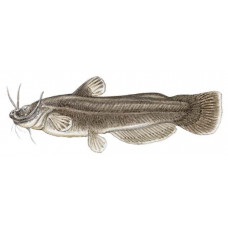Latin name
Noturus funebris
Other names
No information
Identification
The madtom is recognized by its unique fleshy fin. In non-madtom catfish, the fat fin protrudes from the back just in front of the caudal fin. In madtom, the fat fin is continuous with the caudal fin. Madtoms belong to the genus Notomys, which is divided into three subgenera: Noturus, Schilbeodes, and Rabida, each with its own distinctive appearance. Schilbeodes have a dull coloration, usually brown or yellow-brown. Those living in Rabida have colorful markings with numerous stripes and saddle-shaped pigmentation. There is only one species in the subgenus Noturus, the stonecat (Noturus flavus). The Stonecat is simple in appearance, like the Schilbeodes, but no other species can compare in size.
Distribution
Madtoms are found in the wild in the United States and Canada.
Habitat
Most anglers are unfamiliar with madtoms because they are nocturnal, hiding under rocks, logs, and shorelines during the day. In addition, their body markings and coloration (or lack thereof, depending on their preferred habitat) help camouflage them from the eyes of birds, water snakes, and anglers. Most fish prefer the cool, clear waters of small streams, but some species are adapted to living in lakes, large streams, or muddy rivers. Where there is aquatic vegetation and beaver dams, madtoms take full advantage of their many niches. Most have strong habitat preferences and therefore use unique locations. Stonecats tend to inhabit small and large rivers with dams or boulders, and lakes with gravel banks. The black madtom, on the other hand, prefers vegetation rather than gravel or sand in the clear waters of springs, streams, and small rivers. Margined madtoms prefer rocky crevices with fast-moving water in small and medium-sized rivers. In fact, different species are known to prefer specific rock sizes for shelter. Because madtoms are selective in their choice of shelter, they often have problems with the degradation of their preferred habitats.
Size
As adults, stonecats exceed 7 inches and can reach 12 inches in some places. Madtoms range in size from 21⁄2 inches to 61⁄2 inches.
Life history and Behavior
Madtoms begin spawning around mid-April and finish spawning by mid-July. As with most fish, the start and length of the spawning season is highly dependent on water temperature. Madtoms typically begin spawning when the water temperature reaches 64°F and stop spawning when the water temperature exceeds 81°F. During the spawning season, adults are sexually dimorphic, meaning that males look different than females. Female madtoms build nests to raise their young and provide protection after spawning. The nest consists of an area of pebble or gravel substrate that has been cleared of silt and debris. The nest consists of an area of pebble or gravel substrate that has been cleared of silt and debris. Most madtoms prefer to nest under rocks, but some madtoms have been known to nest in discarded cans or soda bottles.
Food and feeding habits
Madtoms are midday feeders, meaning they feed mainly at dusk and dawn. Being insectivores, they mainly feed on gnat larvae, fly larvae, caddisfly larvae, and crustaceans. Most madtoms are not as choosy about food as they are about housing, and eagerly devour any available prey. As a rule, madtoms consume small amounts of stonefly larvae, beetles, black flies, dragonflies, alder flies, and fish flies. Sometimes small fish (e.g., lamprey larvae), a spider, or zooplankton are found in their stomachs. When kept together, large adult madtoms consumed small juvenile madtoms of the same species.
Reproduction
Madtoms are small fish, they have relatively few eggs and are larger than species that do not exhibit parental care. Madtom eggs can be up to 0.2 inches in diameter. They are sticky and adhere to the substrate and to each other. Generally, the female leaves the nest a short time after laying the eggs and passes parental duties to the male. Eggs hatch in 8-10 days, depending on water temperature. After about 21 days of parental care, the male will leave the young alone.
| Classification | |
| Phylum | Chordata |
| Class | Actinopterygii |
| Squad | Siluriformes |
| Family | Ictaluridae |
| Genus | Noturus |
| Species | N. funebris |
| Features | |
| Conservation status | Least Concern |
| Habitat | Bottom |
| Life span, years | No information |
| Maximum body weight, kg | No information |
| Maximum length, cm | 15 |
| Sailing speed, m/s | No information |
| Threat to people | No information |
| Way of eating | Predator |
Madtoms: Black Madtom
Tags: Madtoms: Black Madtom

